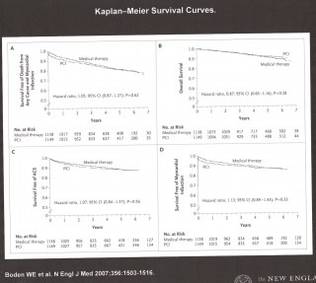Perhaps you’ve heard that biostatistician Paul Meier, co-developer of the Kaplan-Meier survival analysis, died on August 7 at age 87. A pair of illuminating obits on his life ran during the past week in The Washington Post and The New York Times.
Like all medical reporters, I see Kaplan-Meier survival curves for dozens, possibly hundreds of study reports that I cover at medical meetings each year. It’s such a staple of the medical trial landscape that I’ve heard some speakers introduce their slide that shows the curve with a touch of irony in their voice, their secret handshake with the audience that here comes the study’s punchline. And I’ve heard the shuffle of chairs and feet around me as a Kaplan-Meier curve showing a negative result for some drug or procedure comes onto the screen, causing part of the audience to bail from a suddenly less interesting talk.
Kaplan-Meier survival estimates date from a 1958 paper that proposed a novel way to calculate overall survival rates when the items enrolled in a study remain in it for varying periods of time. Remarkably, while Meier approached this issue from the perspective of patients in clinical trials, his collaborator, Edward L. Kaplan, was a mathematician at Bell Labs who was interested in the lifespan of vacuum tubes in buried telephone cables.
Paul Meier’s obituaries made clear that the survival curve he lent his name to was not the only piece of biostatistical bedrock for which he should be remembered. It turns out that he also was critically important in establishing patient randomization as the gold standard for clinical trials.The randomizedcontrolled trial–the RCT–is as much of a biomedical icon as the Kaplan-Meier curve, and this man was integral in the creation of both.
In an interview that Meier did in 2004 with Harry M. Marks, a medical historian from Johns Hopkins, Meier fails to put an exact date on when he began advocating randomization as part of trial design, but says “I started doing that quite early,” before the Salk Polio Vaccine field trials in 1954. Meier also said: “When I said ‘Randomize’ in breast cancer trials I was looked at with amazement by my medical colleagues.”
Later in the interview, when asked what in his career he was most proud of, Meier adds: “It would have to be my promoting of randomization. For a long time randomization was not thought of so highly. I defended randomization every chance I got, and I had a fair number of chances. Two years ago [in 2002] a very distinguished statistician told me that I had a major influence on the Food and Drug Administration’s policies on RCTs. I don’t know how true that was, but if so, it would be something of which I am very proud.”
It’s hard today to imagine the world of major clinical trials without randomization or Kaplan-Meier survival estimates. It’s quite a legacy.
—Mitchel Zoler (on Twitter @mitchelzoler)


